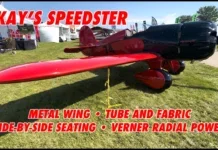 Continuing our celebration of 50 years of the KR, we walk around a very special KR-2S built by Roy Marsh and under the current stewardship of John Bouyea. This KR was the first acknowledged as a stretched “-S” version of the compact, fun-to-fly two seater.
Continuing our celebration of 50 years of the KR, we walk around a very special KR-2S built by Roy Marsh and under the current stewardship of John Bouyea. This KR was the first acknowledged as a stretched “-S” version of the compact, fun-to-fly two seater.
After starting a KR-2 of his own, John Bouyea found a project built by Roy Marsh, which was completed in Santa Maria, California, by 1994. It logged nearly 700 hours through 2007 and then was exported to New Zealand, where it failed the import airworthiness inspection. It was relegated to a shed. After the owner passed away in 2017, this KR was auctioned off. Bouyea purchased it from the auction winner. (Phew!)
“I’ve come into it through great luck,” he says, “and I’m happy and proud to be the present owner and caretaker of 133RM. I was fortunate enough to be able to purchase it, have it shipped back…and I’ve spent the last two and a half years getting the airplane stable and flying again.”
His airplane had a turbocharged Revmaster 2100 (now upgraded to a 2200) good for about 80 hp. “When Roy finished the airplane at Sun ’n Fun in 1995, he was recorded at 190 mph over the 75-mile course. “Roy made several changes to the airplane. It has a thinner airfoil on it. Roy was a P-51 pilot,” John says, describing a man clearly looking for speed.
“I visited Roy when he was building the KR in Santa Maria. The airfoil and spar modifications were designed by his son, who was an aviation engineer.” Bouyea’s airplane has the 14-inch fuselage stretch, “which became standard for the KR-2S,” but it doesn’t have the 2-inch stretch ahead of the main spar. John’s KR also has the standard small tail.
Most of Bouyea’s modifications were to “make the airplane familiar to anyone who knew it when Roy was flying it,” he says. “It’s sprightly, it’s enthusiastic to fly,” he says. “It’s very sensitive, but that’s the fun of the airplane. The [stretched] KR is more stable in pitch,” he says, comparing it to the non-stretched version that he’s flown. “This airplane has a wingspan just under 20 feet,” he says, “almost 2 feet shorter than is standard for the KR-2. As a result, it’s a little bit faster both in cruise and in slow-flight requirements.”
Bouyea, who is based at the Olinger Air Park near Hillsboro, Oregon, routinely “flies off 2000 feet of grass. You can do that with this airplane; you just have to be sure you hit your numbers.” As you can imagine, a light, slick airplane wants you to be right on the approach speed unless you’re willing to risk a long float. (For what it’s worth, John made flying off of our photo location, 2500 feet of asphalt, look easy.)
His care and consideration of Roy Marsh’s KR-2S is plentifully clear, as is his appreciation for his support network. “I’d like to recognize the people who contributed to getting N133RM flying again because it wouldn’t have happened nearly as easily without their help. Most notably, my wife Johnna, as well as Cal Diller, Dr. Ken Melvin and Neal Wright, an A&P/ IA.”
“It’s a great airplane, and I love it,” he says. “If I could have any airplane in the world…well, you’re looking at it.”













